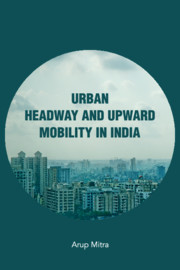Book contents
- Frontmatter
- Contents
- List of Tables
- Acknowledgements
- 1 Analytical Frame
- 2 Assessing the Quality of Cities and Towns
- 3 New Patterns and New Strategies in Indian Urbanization
- 4 Growth, Informal Sector Employment and Poverty
- 5 Upward Mobility of the Disadvantaged Sections
- 6 Erosion of the Caste Factor?
- 7 Changes in a Cultural Variable
- Bibliography
- Index
1 - Analytical Frame
Published online by Cambridge University Press: 30 April 2020
- Frontmatter
- Contents
- List of Tables
- Acknowledgements
- 1 Analytical Frame
- 2 Assessing the Quality of Cities and Towns
- 3 New Patterns and New Strategies in Indian Urbanization
- 4 Growth, Informal Sector Employment and Poverty
- 5 Upward Mobility of the Disadvantaged Sections
- 6 Erosion of the Caste Factor?
- 7 Changes in a Cultural Variable
- Bibliography
- Index
Summary
Urbanization in development economics literature is expected to bring in a spectrum of social and economic transformations. In the backdrop of this understanding, the volume on the one hand focuses on various aspects of urbanization in India and on the other, analyses its impact on different socio-economic variables. Urbanization envisaged as a process in a developing-country context is then able to decipher a wide variety of positive changes which are occurring, though mildly. On the flip side, the rigidity of the social system is also on display, which possibly can be mitigated through significant interventions in addition to the rapid changes in some of the economic variables. The policy implications of evidence-based research are unfolded at the end of each of the chapters.
The volume begins with an analytical frame encompassing various factors that not only lead to urbanization but also unequal urbanization in particular. As per the received theory on urbanization, particularly in the conceptualization of modern economic growth by Kuznets (1966), industrialization per se is the driver. The ‘overurbanization’ thesis of Hoselitz (1953), on the other hand, looked at the urban phenomenon in the absence of adequate industrialization and opportunities for the rural population to shift to productive activities while agriculture pushed them out from the rural areas. The transfer of rural poverty to the urban space with the urban informal sector being the outlet for a residual absorption of labour stands central to this argument. However, with large-scale labour-intensive industrialization, the mobility of population is seen to be accompanied by a reduction in poverty as Lewis (1954) and Kuznets (1966) both had envisaged. Thus, the entire evolution of development was centring round the growth of factory. Since then the urban changes have taken place on a massive scale and the drivers of urban growth have deviated significantly from the traditional conceptualization. The growth of the services sector, international trade, infrastructural hubs, and, more importantly, even activities without much scope for labour-intensive methods have played a strategic role in the urbanization process, highlighting the mutual reinforcements between urbanization and economic development. As Hardt and Negri (2009) suggested, the contemporary metropolis has become a locus of socio-political mobilization analogous to the role of the factory during the initial phases of industrial epoch.
- Type
- Chapter
- Information
- Urban Headway and Upward Mobility in India , pp. 1 - 14Publisher: Cambridge University PressPrint publication year: 2020



